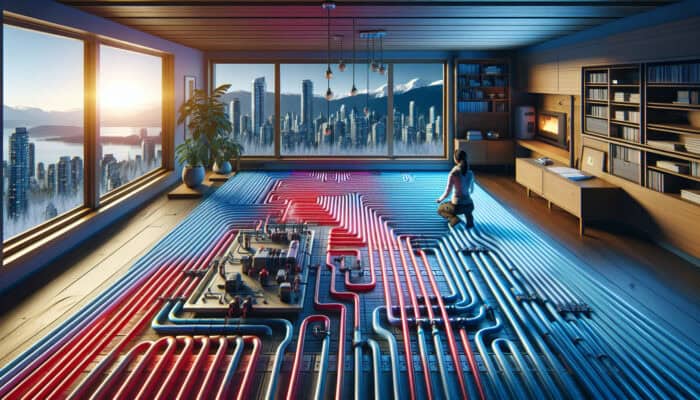Comprehensive Guide to Hydronic Radiant Floor Heating Systems
What Is the Functionality of Hydronic Radiant Floor Heating?

The Hydronic Radiant Floor Heating Services in South Vancouver present a groundbreaking method for achieving home warmth by employing water as the primary heating medium. This innovative approach is especially beneficial in climates like South Vancouver, where maintaining a stable indoor temperature is vital for comfort and well-being during the chilly months. The system operates by circulating warm water through a network of pipes installed beneath the flooring, ensuring that heat is distributed uniformly throughout the space. This effectively removes cold spots that are often found with traditional heating systems, creating an inviting and cosy atmosphere that significantly enhances comfort in both residential and commercial environments.
Choosing hydronic radiant floor heating offers a plethora of advantages, including:
- Outstanding energy efficiency which leads to lower utility bills
- Consistent heating across all areas of the space
- Marked reduction in the circulation of allergens and dust particles
- Quiet operation, free from the disturbances caused by forced-air systems
- Enhanced indoor air quality
- Potential for increased property market value
- Compatibility with a variety of flooring options
- Environmentally friendly heating solution that promotes sustainability
Essential Parts of a Hydronic Heating System You Should Know
A hydronic heating system comprises several key components, each crucial to its overall functionality and efficiency. The boiler acts as the heart of the system, heating water before it circulates through the tubing. Typically constructed from durable materials such as PEX or copper, the tubing is meticulously arranged beneath the flooring to ensure optimal heat distribution. Furthermore, the manifold functions as the central distribution hub for heated water, allowing precise control over individual heating zones throughout the residence.
Understanding these components is essential for both the installation and maintenance of the system. For example, the efficiency of the boiler has a direct impact on energy consumption, while the strategic layout of the tubing maximises thermal transfer efficiency. Additionally, modern controls and programmable thermostats enable homeowners to manage their heating systems conveniently, adjusting temperatures to align with their comfort preferences and lifestyle requirements.
Why Is Hydronic Heating a Superior Choice Compared to Other Heating Options?
Choosing hydronic heating brings forth an array of benefits that render it a highly appealing option for homeowners in South Vancouver. The most significant advantage is the exceptional comfort provided by this system, which maintains a consistent temperature throughout the entire home. Unlike conventional heating systems that can cause drafts or uneven warmth, hydronic systems distribute heat evenly from the floor upwards, greatly improving the living experience.
Another substantial benefit is the impressive energy efficiency of hydronic heating systems. These systems operate at lower temperatures than forced-air alternatives, resulting in a notable decrease in energy consumption. Over time, these savings can compensate for the initial investment, making hydronic heating a prudent long-term choice. Moreover, these systems positively contribute to indoor air quality by limiting the circulation of dust and allergens, making them particularly suitable for allergy sufferers. This comprehensive approach to heating not only elevates comfort levels but also promotes overall health and wellness.
Insights from Experts on Hydronic Radiant Floor Heating Services in South Vancouver

What Are the Best Practices for Installing Hydronic Heating?
To guarantee a successful installation of hydronic radiant floor heating, it is vital to adhere to best practices that enhance both system efficiency and durability. Proper insulation is paramount, as it ensures that heat is retained within the living space rather than being lost to the environment. Additionally, a well-planned tubing layout is essential for ensuring even heat distribution and preventing the occurrence of cold spots. Collaborating with skilled professionals who specialise in hydronic systems is crucial, as their expertise can facilitate a seamless installation experience.
Real-world examples from installations in South Vancouver highlight the importance of following these best practices. For instance, a local homeowner successfully transformed their basement into a warm living space using hydronic heating. By insulating the perimeter and carefully planning the tubing layout, they were able to create an inviting environment that remains comfortable throughout the winter months. Such successful cases underline the significance of employing correct installation techniques to achieve effective and long-lasting heating solutions.
How Can Homeowners Optimize Energy Efficiency with Hydronic Heating?
Maximising energy efficiency in hydronic radiant floor heating systems involves adopting several practical strategies that homeowners can easily implement to ensure optimal performance. Regular maintenance is crucial; periodic inspections for leaks or signs of wear can prevent energy loss and avert costly repairs later on. Homeowners should also ensure that their properties are well insulated, as this minimises heat loss and reduces overall energy consumption.
Investing in smart controls can significantly enhance system efficiency. These advanced devices allow homeowners to schedule heating in accordance with their daily routines, ensuring that rooms are heated only when occupied. Integrating these smart controls within home automation systems can lead to even greater energy savings. Simple practices, such as keeping boiler systems clean and monitoring pressure levels, also contribute to improved system performance and reduced energy expenses.
What Common Challenges Might Arise and What Are Their Solutions?

While hydronic radiant floor heating systems provide numerous benefits, they can also present certain challenges. Common issues include leaks, inconsistent heating, and maintenance demands. Leakage may occur due to pipe wear, which can lead to water damage and decreased efficiency. Conducting regular system checks can help identify leaks early, preventing more significant and costly damage.
Inconsistent heating can frustrate homeowners and often stems from improper tubing layout or issues with the manifold. Solutions may involve adjusting the system to facilitate even heat distribution. Regular maintenance executed by professionals skilled in hydronic systems within South Vancouver is essential for effectively addressing these challenges. By proactively managing potential issues, homeowners can fully benefit from their hydronic heating systems.
What Comprehensive Benefits Can Be Expected from Hydronic Radiant Floor Heating?
The extensive advantages of hydronic radiant floor heating render it a highly desirable option among homeowners in South Vancouver. One of the most significant benefits is the system’s ability to provide uniform heat distribution. Unlike forced-air systems that can create drafts and temperature disparities, hydronic heating consistently radiates warmth from the ground up, significantly improving comfort levels in every room of the home.
Additionally, the energy efficiency of hydronic systems translates into reduced heating costs, establishing them as a financially sound choice in the long term. The reduction in allergens and dust circulation, due to the absence of forced air, enhances indoor air quality, which positively impacts the health of residents. Collectively, these benefits create a compelling case for the installation of hydronic radiant floor heating in homes throughout South Vancouver.
How Does Hydronic Heating Impact Property Value?
Investing in hydronic radiant floor heating can significantly boost property value, making it an attractive option for homeowners seeking to enhance their living environments. The comfort and energy efficiency provided by this system are appealing to potential buyers, who recognise the long-term benefits associated with lower utility costs and improved air quality. Homes equipped with hydronic heating systems often stand out in the competitive real estate market, attracting buyers who prioritise comfort and sustainability.
In South Vancouver, where winters can be particularly harsh, an efficient heating system can considerably increase a property's desirability. Many buyers are prepared to pay a premium for homes featuring modern heating solutions like hydronic radiant floor heating, thereby elevating the property’s overall market value. This investment not only provides immediate comfort but also serves as a strategic enhancement for future resale opportunities.
Diving Deeper into the Mechanics of Hydronic Radiant Floor Heating
What Is the Process Behind Heat Distribution?
The process of heat distribution in hydronic radiant floor heating systems is both efficient and straightforward. It commences with the boiler, which heats water to the desired temperature. This hot water subsequently flows through a network of tubes positioned beneath the flooring. As the water circulates, it releases heat into the floor, which then radiates upwards, effectively warming the entire room.
This heating method is particularly effective as it leverages the natural tendency of heat to rise, providing a consistent temperature throughout the area, unlike traditional heating systems that may create hot air pockets near the ceiling. Hydronic heating guarantees that every corner of the room reaches a comfortable temperature, enhancing the indoor atmosphere and making it a popular choice among homeowners in South Vancouver.
What Are the Core Components of the System?
Understanding the core components of a hydronic radiant floor heating system is essential for both its installation and maintenance. The primary elements include the boiler, which initiates the heating process by warming the water; the tubing, which transports hot water beneath the flooring; the manifold, responsible for distributing the heated water to various zones; and the controls that manage the temperature settings.
Each component significantly contributes to the system's efficiency. For example, the boiler's effectiveness directly influences energy consumption, while the tubing arrangement has a major impact on heat distribution. Familiarity with these components empowers homeowners to proactively address any issues, ensuring their systems operate effectively and endure long in the unique climate of South Vancouver.
How Is the Hydronic Heating System Managed and Controlled?
Managing a hydronic radiant floor heating system involves utilising thermostats and smart controls, enabling homeowners to fine-tune indoor temperatures with precision. These devices facilitate users in establishing specific heating schedules, ensuring that rooms are warmed only when occupied and conserving energy during unoccupied periods. Advanced smart controls can seamlessly integrate with home automation systems, allowing for remote adjustments.
The ability to finely control temperature not only enhances comfort but also boosts energy efficiency. For instance, homeowners can set lower temperatures during the night or when away, resulting in significant energy savings over time. This level of control is particularly beneficial in South Vancouver, where weather conditions may vary considerably, emphasising the necessity for reliable and efficient heating solutions.
What Are the Diverse Benefits of Hydronic Radiant Floor Heating?
The advantages of hydronic radiant floor heating extend beyond mere comfort, encompassing energy savings and health improvements as well. This system operates at lower temperatures compared to traditional heating options, yielding substantial reductions in energy consumption. Homeowners can enjoy lower utility bills while effectively maintaining a warm and welcoming living environment.
Moreover, hydronic systems enhance indoor air quality by reducing the circulation of allergens, making them particularly beneficial for households with allergy sufferers or respiratory conditions. The consistent warmth delivered by the heating system fosters a sense of comfort, creating an inviting atmosphere throughout the home. With its array of advantages, hydronic radiant floor heating stands out as an exceptional choice for homeowners in South Vancouver who prioritise comfort, efficiency, and health.
What Installation Considerations Must Be Addressed?
When installing hydronic radiant floor heating, several critical factors must be considered to ensure optimal performance and efficiency. Firstly, careful planning of the tubing layout is essential, as proper spacing and configuration are vital for achieving even heat distribution. Additionally, the type of flooring material can significantly affect the system’s efficiency; for example, tile and concrete tend to retain heat more effectively than carpet.
Proper insulation is another crucial element; adequate insulation beneath the flooring helps to prevent heat loss, thereby maximising the system’s efficiency. Engaging with experienced professionals for the installation process is highly advisable, as their expertise can guide homeowners through these considerations, ensuring a seamless integration of hydronic heating into their homes. By addressing these factors, homeowners can reap the long-term benefits of a well-functioning hydronic heating system.
Step-by-Step Process for Installing Hydronic Radiant Floor Heating
What Are the Key Steps for a Successful Installation?
The successful installation of hydronic radiant floor heating follows a sequence of precise steps that ensure the system performs as intended. The process typically begins with site preparation, which includes a thorough assessment of the existing flooring and making necessary modifications to accommodate the tubing. Next, the following step involves laying out the tubing according to a pre-planned design, ensuring optimal heat distribution throughout the space.
Once the tubing layout is complete, it is connected to the boiler and manifold, finalising the installation process. Each step requires meticulous attention to detail and professional expertise to prevent future complications and guarantee efficiency. Essential steps for homeowners in South Vancouver to consider during installation include:
- Conducting a comprehensive site assessment
- Planning the tubing layout for optimal heat distribution
- Installing insulation beneath the flooring
- Laying the tubing with precision
- Connecting the system to the boiler and manifold
- Testing the system for leaks and overall functionality
- Finalising the flooring installation
What Materials Are Essential for the Installation?
The materials required for installing hydronic radiant floor heating are crucial for ensuring the system’s longevity and efficiency. Key components include PEX tubing, which is flexible and resistant to corrosion, making it an ideal choice for this application. Additionally, insulation is necessary to prevent heat loss and enhance system efficiency. The manifold serves as the central distribution hub, while a reliable boiler is essential for effectively heating the water.
Homeowners in South Vancouver should prioritise the quality of materials used, as they directly influence the system’s performance and durability. While high-quality materials may require a larger initial investment, they typically lead to lower maintenance needs and an extended system lifespan. Understanding the local market’s availability and costs of these materials can aid homeowners in making informed decisions when planning their installation.
What Is the Typical Installation Timeline?
The duration required to install hydronic radiant floor heating can differ based on various factors, including the size and complexity of the residence. Generally, homeowners can anticipate the installation process to take between 2 and 5 days. Key factors influencing the timeline include the existing flooring type, the complexity of the tubing layout, and any necessary modifications to the space to accommodate the system.
Homeowners should be prepared for minimal disruption during the installation process, as professionals will need access to various parts of the home. Proper planning and communication with the installation team can help ensure the project stays on schedule, allowing homeowners to enjoy their new heating system as quickly as possible. Understanding the installation timeline can facilitate smoother transitions and realistic expectations.
Uncovering the Advantages of Hydronic Radiant Floor Heating
How Does Hydronic Heating Elevate Indoor Comfort?
Hydronic heating dramatically enhances indoor comfort through uniform heat distribution across the entire space. Unlike traditional heating methods that create hot and cold spots, hydronic systems radiate warmth from the ground up, ensuring that each room remains consistently warm and inviting. This gentle heating approach effectively eradicates drafts and fluctuations in temperature, creating a cosy atmosphere.
The psychological benefits of warm floors should not be overlooked; stepping onto a heated surface heightens feelings of comfort and relaxation. Homeowners in South Vancouver particularly value the consistent warmth provided by hydronic heating, especially during the frigid winter months. The overall result is an improved indoor living experience that significantly enhances residents' quality of life.
What Energy Efficiency Benefits Does Hydronic Heating Provide?
Energy efficiency stands out as one of the most compelling benefits of hydronic radiant floor heating. This system operates at lower temperatures than traditional heating methods, resulting in reduced energy consumption and lower utility costs over time. Homeowners can achieve substantial savings by minimising heat loss and optimising energy usage during the heating season.
When comparing hydronic heating to other systems, such as forced air, the efficiency advantages become even clearer. Forced-air systems often require higher temperatures to compensate for heat loss, leading to increased energy expenses. In contrast, hydronic heating maintains comfortable temperatures with lower operational demands, making it a financially advantageous choice for homeowners in South Vancouver.
How Does Hydronic Heating Impact Indoor Air Quality?
Hydronic radiant floor heating positively affects indoor air quality by minimising allergens and dust circulation within the home. Traditional forced-air systems can worsen respiratory issues by dispersing dust and allergens into the air, creating challenges for individuals with allergies or asthma. Conversely, hydronic systems operate quietly and without the need for forced air, resulting in a cleaner indoor environment.
This improvement in air quality is crucial for residents' overall health and well-being. Homeowners in South Vancouver can benefit from lower allergen levels, fostering a safer and more pleasant living space. Additionally, the even heating provided by hydronic systems helps maintain consistent humidity levels, further enhancing indoor air quality.
- Reduced allergens circulating in the air
- Minimised dust movement
- Improved respiratory health
- Consistent humidity regulation
- Overall enhanced comfort
Maintenance and Troubleshooting for Hydronic Heating Systems
What Are the Essential Maintenance Tasks for Hydronic Heating?
Regular maintenance is vital for ensuring the efficiency and longevity of hydronic radiant floor heating systems. Key maintenance tasks include inspecting for leaks, balancing the system, and performing annual boiler servicing. These routine checks help identify potential issues early on, preventing costly repairs and ensuring optimal performance.
Homeowners in South Vancouver should implement a maintenance schedule incorporating the following routine inspections:
- Inspecting tubing for leaks or damages
- Checking system pressure and adjusting as necessary
- Testing the boiler’s efficiency
- Cleaning filters and vents related to the heating system
- Flushing the system periodically to eliminate buildup
- Verifying the functionality of thermostats and controls
- Scheduling annual professional inspections for comprehensive evaluations
By prioritising these tasks, homeowners can ensure their hydronic heating systems operate efficiently and effectively for many years to come.
How Can You Troubleshoot Common Hydronic Heating Problems?
Troubleshooting common issues associated with hydronic radiant floor heating systems involves promptly recognising problems and implementing suitable solutions. Frequent concerns may include uneven heating, leaks, and system failures. Homeowners should begin by assessing their system for visible signs of trouble, such as cold patches on the floor or rising energy bills, which can indicate inefficiencies.
To address uneven heating, homeowners may need to adjust the flow rate from the manifold or investigate potential blockages in the tubing. If leaks are detected, identifying the source and hiring a professional for repairs is crucial to prevent further damage. While homeowners can manage some troubleshooting tasks, more complex issues are best handled by qualified professionals with expertise in hydronic systems within the South Vancouver area.
What Signs Indicate a System Failure?
Recognising the early signs of system failure can save homeowners from expensive repairs and prolonged downtime. Common indicators include cold spots on the floor, visible leaks, and a noticeable rise in energy bills. These symptoms often signify underlying issues that require immediate attention.
Homeowners should remain vigilant in monitoring their hydronic heating systems and should promptly contact a professional if they observe any unusual performance changes. Early detection of problems can lead to straightforward repairs instead of extensive system failures, ensuring the heating system remains efficient and effective throughout its operational life.
Financial Aspects of Hydronic Radiant Floor Heating
What Is the Anticipated Initial Investment?
The initial investment for hydronic radiant floor heating varies based on several elements, including the home's size, chosen materials, and the complexity of the installation process. Homeowners should expect costs for essential components such as PEX tubing, a boiler, and insulation, in addition to labour costs for professional installation.
While the upfront expenses may appear significant, it is essential to view this investment in light of long-term savings. Hydronic heating systems typically lead to reduced energy bills and increased property value over time, making this a prudent financial choice for homeowners in South Vancouver. Additionally, considering the system’s overall impact on comfort and efficiency can help justify the initial outlay.
What Are the Recurring Operating Costs?
Operating costs for hydronic radiant floor heating systems depend on various factors, including local energy prices, system efficiency, and individual usage patterns. Generally, these systems are recognised for their cost-effectiveness, often resulting in lower heating expenses compared to traditional heating methods.
Homeowners should factor in the potential for long-term energy savings when assessing their operating costs. By maintaining their systems properly and utilising smart controls to optimise energy use, they can further decrease expenses associated with hydronic heating. Understanding the long-term financial benefits reinforces hydronic heating as a sustainable option for residents in South Vancouver.
Are There Incentives or Rebates Available for Installation?
Incentives and rebates can significantly mitigate the initial costs of installing hydronic radiant floor heating systems. Homeowners in South Vancouver should investigate local programs, utility company offerings, and federal initiatives that promote energy-efficient home enhancements.
Potential incentives may encompass grants, tax credits, or discounted energy rates for those investing in energy-efficient systems. Staying informed about current opportunities can provide financial relief and encourage homeowners to adopt sustainable heating solutions that benefit both their finances and the environment. Current incentives may include:
- Provincial rebates for energy-efficient home upgrades
- Federal tax credits for eco-friendly heating systems
- Utility company incentives for energy conservation
- Grants for environmentally sustainable home improvements
How Does Maintenance Affect Overall Costs?
Regular maintenance plays a crucial role in managing the expenses associated with hydronic radiant floor heating systems. Although maintenance may incur an initial cost, it ensures that the system operates at peak efficiency, ultimately lowering energy bills and preventing costly repairs. Homeowners should budget for routine checks, potential repairs, and system flushing to maintain optimal performance.
Neglecting maintenance can lead to decreased efficiency and increased operational costs over time. By prioritising regular upkeep, homeowners in South Vancouver can enjoy the long-term benefits of their hydronic heating systems while minimising unexpected expenses related to system failures or inefficiencies.
Can Financing Options Assist with Upfront Costs?
Financing options can help homeowners manage the initial costs of installing hydronic radiant floor heating systems. Various financial solutions are available, including loans, leases, and payment plans, allowing homeowners to spread the initial investment over an extended period.
Exploring financing options can make hydronic heating more accessible for many homeowners, particularly those concerned about the upfront financial burden. Understanding the terms and interest rates associated with these options is vital for evaluating their overall cost impact. By utilising financing, homeowners in South Vancouver can invest in efficient heating solutions while maintaining budget flexibility.
Choosing the Right Service Provider in South Vancouver
What Key Criteria Should You Consider When Selecting a Service Provider?
When selecting a service provider for the installation and maintenance of hydronic radiant floor heating, several critical factors must be evaluated to ensure a successful partnership. Essential considerations include the provider’s experience in the industry, relevant certifications, and positive customer feedback. A reputable provider should possess a proven track record of successful installations and satisfied clientele.
Local expertise is particularly significant, as a provider familiar with the unique climate and building codes in South Vancouver can design and implement systems that operate effectively under local conditions. Homeowners should prioritise companies that are dedicated to quality and customer service, ensuring that their hydronic heating systems are in capable and reliable hands.
How Should You Assess Service Quotes?
Evaluating service quotes for hydronic radiant floor heating installation requires careful consideration of various factors. Homeowners should compare quotes based on the scope of work, included materials, and total costs. Obtaining multiple quotes is essential to ensure competitive pricing and a comprehensive assessment of the project’s total expenses.
It is crucial to be cautious of unusually low prices, as they may indicate inferior work or hidden costs. Homeowners should seek detailed explanations of what each quote includes, enabling informed decisions based on value rather than merely on price. Transparency in quotes and the provider’s willingness to answer questions can also reflect the company’s professionalism and reliability.
What Benefits Come with Local Expertise?
Local expertise in hydronic radiant floor heating installation provides several advantages that enhance the system’s overall effectiveness. Service providers familiar with the regional climate and building codes in South Vancouver can design systems tailored to local conditions, ensuring optimal performance and energy efficiency.
Moreover, local providers understand the specific needs of homeowners in the area, enabling them to recommend appropriate materials and installation techniques. This familiarity fosters a collaborative relationship, enhancing communication and trust between homeowners and service providers. Ultimately, selecting a local expert can lead to a more successful and satisfying experience for homeowners investing in hydronic heating systems.
How Can You Verify a Service Provider’s Credentials?
Verifying a service provider’s qualifications is essential to ensure that homeowners receive quality service and installation for their hydronic radiant floor heating systems. Homeowners should start by confirming the validity of licenses and insurance coverage, as these indicate professionalism and compliance with local regulations.
Additionally, professionals should hold certifications from recognised industry organisations, demonstrating a commitment to ongoing education and adherence to best practices. Homeowners can further verify credentials by seeking out customer testimonials and reviews, ensuring that the provider has established a reputable standing for quality work within the South Vancouver community. This thorough vetting process will help ensure a successful installation and ongoing support for the hydronic heating system.
Frequently Asked Questions
What are hydronic radiant floor heating systems?
Hydronic radiant floor heating systems utilise heated water circulating through pipes underneath the floor to provide consistent warmth and comfort throughout the space.
How energy-efficient are hydronic heating systems?
Hydronic heating systems are highly energy-efficient, often resulting in lower utility expenses compared to traditional heating methods due to their ability to function at lower temperatures.
What are the installation requirements for hydronic heating?
Installation requires careful planning of the tubing layout, adequate insulation, and high-quality materials to ensure the system operates effectively and efficiently.
How long does it take to install hydronic floor heating?
Installation typically spans between 2 and 5 days, depending on the home’s size and complexity, allowing for minimal disruption during the process.
What maintenance is required for hydronic heating systems?
Regular maintenance tasks encompass checking for leaks, balancing the system, and conducting annual boiler servicing to ensure optimal performance and efficiency.
Can hydronic heating systems enhance property value?
Yes, hydronic radiant floor heating systems can augment property value by providing comfort and energy efficiency, thereby making homes more appealing to potential buyers.
What signs indicate a failing hydronic heating system?
Indicators of system failure include cold spots on the floor, visible leaks, and increased energy bills, signalling the need for prompt attention and resolution.
Are there any rebates available for installing a hydronic heating system?
Homeowners may qualify for various incentives and rebates offered at the local and federal levels to help offset the initial costs associated with hydronic heating installation.
How do I select a reputable service provider?
Look for experience, certifications, and customer reviews when selecting a service provider. Local expertise and a strong reputation are also crucial factors to consider.
What financing options are available for hydronic heating systems?
Financing options, such as loans or payment plans, can help homeowners manage upfront costs, making hydronic heating more accessible while offering budget flexibility.
Connect with us on Facebook!
Presented By: Hydronic Radiant Floor Heating in South Vancouver
The Article: Hydronic Radiant Floor Heating Services in South Vancouver First Published On: https://pacificbluemechanical.ca/
The Article Hydronic Radiant Floor Heating in South Vancouver Was Found On https://limitsofstrategy.com

